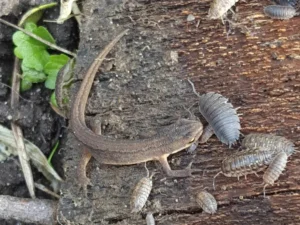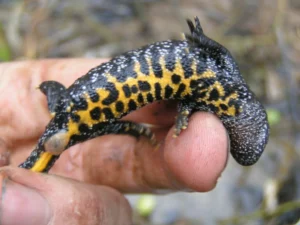Have you ever seen a newt resting under a log, or gliding through a pond, and wondered if it was guarding that spot? Some animals are fiercely territorial, chasing away anything that comes too close. But what about newts, are they territorial?
Newts aren’t strongly territorial, but they can act a little territorial in certain situations, especially during breeding season or when hiding spots are limited.
Most of the time, newts don’t defend a “home base” like birds or mammals. They move around looking for food, shelter, and safe places to rest.
Still, there are moments when you’ll notice flashes of territorial behavior.
What Does Territorial Really Mean?
Before we talk about newts, it helps to ask: what does territorial mean in the first place? A territorial animal will guard an area (big or small) from others of its kind.
Think of a robin singing from a branch, warning others to stay away from its nesting tree.
Or a wolf pack marking the edges of its hunting grounds.
Territorial behavior often comes with aggression: chasing, biting, or posturing to warn others. For newts, though, it doesn’t usually go that far.
How Newts Spend Their Days
Most of the year, newts quietly move around searching for food, small insects, worms, or tiny aquatic creatures.

Food is scattered, so it makes more sense to keep moving instead of defending a space.
In ponds or wetlands, many newts share the same area. You might find several under one log or near the same water plants.
This shows they can actually tolerate each other pretty well when they’re not competing for mates.
But when spring comes, things change.
Breeding Season Makes Newts More Competitive
The clearest time you’ll see territorial-like behavior is during breeding season. When newts return to ponds in spring, males compete for females.
They don’t guard large areas, but they sometimes defend a small space around a female.
Male newts show off by fanning their tails, flashing their bright breeding colors, and releasing pheromones into the water.

If another male gets too close, they might chase or nudge him aside.
For example, smooth newt males in Europe spread out in shallow ponds, each trying to attract females.
If two males end up too close, they’ll display aggressively with quick jerks and tail flicks to show dominance.
So while they don’t hold territories all year, breeding season does bring bursts of competition.
Shelter and Hiding Spots Can Cause Tension
Another time you might see territorial behavior is when hiding spots are limited. A good place under a rock, in a crevice, or among dense plants can mean safety from predators.
If several newts want the same spot, one might push another away.
But even then, they don’t usually fight for long. It’s more about quick, short-term competition.
Imagine lifting a log in a damp woodland. You might find two or three newts under it, each in a corner.

They’re not guarding the log as their property, but they do notice if another newt crowds in too close.
Are Some Newt Species More Territorial?
Not all newts act exactly the same. Some species are a little more aggressive than others:
-
Smooth newts (Lissotriton vulgaris): Males can get pushy during breeding, but they don’t guard big territories.
-
Eastern newts (Notophthalmus viridescens): Juveniles called “red efts” wander widely on land and don’t defend territories. Adults in water may compete during mating season but usually tolerate each other.
-
Alpine newts (Ichthyosaura alpestris): Males show elaborate displays and can be more aggressive during breeding, but only for a short time.
Across species, the pattern is the same, tolerant most of the time, with short bursts of competition.
How Do Newts Compare With Truly Territorial Animals?
If you compare newts to animals like lizards, frogs, or birds, the difference is clear. Many lizards defend territories fiercely, doing push-ups or flashing colors to scare rivals.
Male frogs stake out calling spots in ponds and defend them.
Newts don’t go that far. Their displays are more about winning mates than guarding land.
They don’t fight long battles or defend borders. They move around and stay flexible instead.
Do Newts Fight Each Other?
You might wonder if these small disputes ever turn into real fights. Most of the time, they don’t.
Newts rely on chases, nudges, or displays rather than serious combat. They’re soft-bodied and not built for hard fighting.
Still, males have been seen biting or grappling briefly during breeding season.
These scuffles don’t usually cause lasting harm, but they do show competition can sometimes get physical.
Why Aren’t Newts More Territorial?
It comes down to their needs and their environment. Being territorial takes energy. Animals that guard large areas need to patrol them, mark them, and fight rivals. For newts, it just wouldn’t pay off.

Their food (small insects and invertebrates) is scattered and unpredictable. Guarding one area wouldn’t guarantee enough to eat.
And since newts live both on land and in water, their homes change a lot. Flexibility is more useful than defending a patch.
What About Pet Newts?
If you’ve kept newts in a tank, you may have noticed how they behave with each other. Most of the time, they tolerate tank-mates, even resting on the same rocks.
But during breeding season, males may chase each other or try to stay near females.
In small tanks, competition for hiding places can make them look territorial.
That’s why it’s best to provide lots of shelters (rocks, caves, or plants) so each newt can find a spot.
How Newts Compare to Other Amphibians
Comparing newts to other amphibians helps put them in context.
Frogs often defend calling spots, while some salamanders, like red-backed salamanders, guard small patches of forest floor.
Newts lean more toward tolerance. They may defend a mate briefly, but they don’t keep permanent territories.
That matches their lifestyle, since they shift between land and water and need moisture and shelter more than borders.
Conclusion
So, are newts territorial? Not really. They don’t patrol borders or hold permanent home bases.
Most of the year, they move freely, often sharing space with others.
But during breeding season, or when shelter is limited, they can show short bursts of competition, chasing rivals, nudging, or displaying.
In the end, newts depend more on flexibility than territory. That adaptability has helped them thrive in ponds, forests, and wetlands for millions of years.
Hi, my name is Ezra Mushala, i have been interested animals all my life. I am the main author and editor here at snakeinformer.com.

